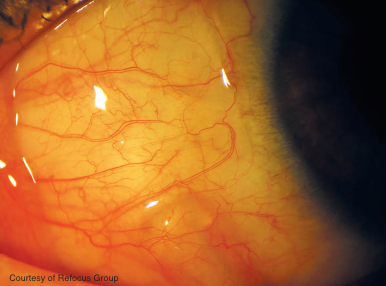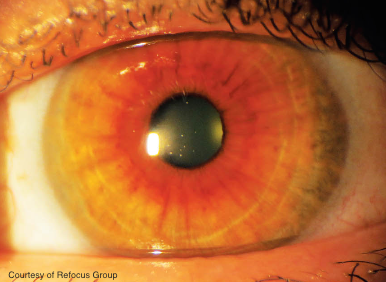Article
What a novel scleral implant may mean for presbyopia
A scleral implant surgery system for presbyopia is being evaluated in a phase III study. One investigator talks about his experience.
Reviewed by Ken Beckman, MD

Columbus, OH-Though enrollment was only recently completed in a pivotal study evaluating a novel scleral implant surgery system (VisAbility Micro-Inserts, Refocus Group) as a solution for presbyopia, anecdotal reports from investigators in the phase III study are very encouraging.
Primary outcome data are being collected after 12 months of follow-up, and so it will be some time before those results are available. Inferior temporal quadrant
Related: Consider latest excimer laser techniques for presbyopia
Ken Beckman, MD, entered 14 patients at his site, Comprehensive Eyecare of Central Ohio, Westerville, and noted patients are all doing well and are very happy having undergone the procedure.
With postoperative follow-up ranging between 6 and 9 months, the patients are benefiting from good uncorrected vision at near and intermediate without experiencing loss of distance vision or significant safety issues, said Dr. Beckman, clinical assistant professor of ophthalmology, The Ohio State University, Columbus.

More: Topical drops show promise as treatment for presbyopia
“This is an exciting new procedure for presbyopia that is very easy to perform, provides gratifying results, and has many advantages compared with other surgical presbyopia solutions,” Dr. Beckman said. “The scleral implant procedure is binocular, provides a full range of vision, does not affect the visual axis or induce optical aberrations, and it is reversible.”
The implant system is an investigational device and is limited by United States law to investigational use. This device holds a CE mark and is currently for sale and use in the European Union.
Sponsored: 5 reasons toric IOLs are the best choice for managing astigmatism
About the procedure (with video)
About the procedure
The procedure involves insertion of four PMMA segments into scleral tunnels in order to expand scleral tissue around the lens and restore physiological conditions necessary for accommodation. Dr. Beckman noted that the instrumentation used for creating the scleral tunnels and inserting the implant segments, as well as the segments themselves, represent an improvement over earlier iterations.

Inferior nasal quadrant
Trends in U.S. refractive surgery: 2015 ISRS survey
As a result, the surgery has a quick learning curve, is highly repeatable, and delivers consistent outcomes.
It involves placement of a docking station that is fixed at the limbus, stabilizes the eye, and provides a guide for tunnel creation by the proprietary scleratome. The scleratome creates tunnels at a depth of 400 μm, located 4 mm from the limbus, and measuring 4 mm in length.
More: How endothelial cell loss in DSEK compares to PK
The two-piece segment implants are placed and locked in a two-step procedure with the first piece delivered into the tunnel using a shuttle assembly and then secured with insertion of a second interlocking piece.
Surgical procedure (with video)
This video represents an edited version of the VisAbility procedure performed by Ken Beckman, MD that does not show the final closing technique of the conjunctiva which is secured to the limbus with 9-0 Vicryl sutures.
“Originally, the surgery was all hands on rather than automated, and it was difficult to achieve the proper position, length, and depth of the tunnels,” Dr. Beckman said. “The procedure now is very repeatable, and in my training as an investigator for the phase III trial, I was very comfortable with the procedure after just a few patients.”
The procedure takes about 15 to 20 minutes per eye and is intended to be performed as bilateral simultaneous surgery. In the clinical trial, however, the second eye surgery is performed about 2 to 4 weeks after the first eye.

Primary gaze images from a patient at an early (1 month) postoperative visit
After the procedure, patients wait for their pupils to recover before going home, and they may experience some achiness that lasts from a few hours to a few days. Otherwise, the most bothersome symptom is redness related to subconjunctival hemorrhage that can persist about 2 weeks.
Recent: Flying Eye Hospital aims to prevent blindness worldwide
The pivotal study enrolled 360 patients ages 45 to 60 years and will follow them to 24 months. Eligible patients had to have 20/20 or better best-corrected distance visual acuity and both distance-corrected near visual acuity (40 cm) and uncorrected near visual acuity (40 cm) of 20/50 to 20/80 in each eye.
Preoperative manifest refraction spherical equivalent in each eye had to be -0.75 to +0.50 D with ≤ 1.00 D of astigmatism, cycloplegic refraction spherical equivalent (CRSE) had to be within 0.50 D of the MRSE, and subjects had to require an add of at least +1.25 D to read 20/20 at near.
More: Why selective two-photon collagen crosslinking is a better option
Ken Beckman, MD
Dr. Beckman is an investigator for Refocus Group but has no other relevant financial interests to disclose.
Newsletter
Don’t miss out—get Ophthalmology Times updates on the latest clinical advancements and expert interviews, straight to your inbox.






